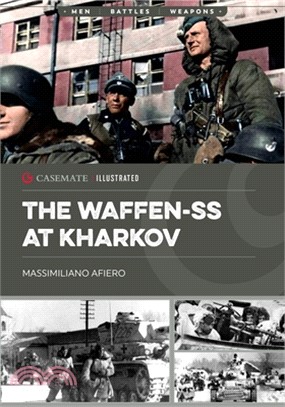The Waffen-SS at Kharkov: February-March 1943
商品資訊
ISBN13:9781636244396
出版社:CASEMATE
作者:Massimiliano Afiero
出版日:2024/08/31
裝訂:平裝
商品簡介
商品簡介
At the beginning of 1943, the German armed forces were in crisis on the southern front in Russia. The Soviets had launched a series of offensives from November 1942 that pushed the Germans back hundreds of kilometers. The Germans had no more significant reserves available, and enormous breaches had opened between defensive lines. In early January 1943, the Soviets attacked again, with the aim of reconquering the industrial city of Kharkov and destroying the remaining German and Axis troops in southern Ukraine, including the 4. Panzerarmee, 1. Panzerarmee, Armeeabteilung Hollidt and Armeeabteilung Fretter‐Pico.
After the encirclement of 6. Armee at Stalingrad and the destruction of the Axis forces there, the loss of these four armies would certainly have led to German defeat on the Eastern Front. Believing victory was near, Stalin and his generals decided to launch their new offensives even before the garrison of Stalingrad surrendered. The main effort fell on Army Group Don, newly formed and with little forces available. Facing a massive offensive, Commander Erich von Manstein was ordered to hold the city at any cost, risking the destruction of two divisions of the Waffen‐SS and the "Grossdeutschland" army division. SS Panzer Corps commander Paul Hausser disobeyed Hitler's order and ordered the retreat from Kharkov, saving the two SS divisions. This meant that Manstein had at his disposal forces needed to launch his counteroffensive.
The subsequent battles for Kharkov saw the three divisions of the Waffen‐SS--Leibstandarte Adolf Hitler, Das Reich and Totenkopf-- fighting together for the first time. In the first phase of the offensive, the SS Das Reich and Totenkopf marched 100 kilometers south of Kharkov, blocking the Soviet army from capturing the bridges over the Dnieper River, while the Leibstandarte successfully defended the corps supply base in Krasnograd. After protecting the bridges over the Dnepr, the Das Reich and Totenkopf units headed north and regained control of the vital railway network south of Kharkov. The Soviet 3rd Tank Army was forced to abandon its attack against Krasnograd to regroup south of Kharkov and protect the city from Hausser's divisions. At that point the Leibstandarte joined the other divisions of the corps SS to eliminate Soviet forces and recapture Kharkov. With its reconquest, Southern Ukraine returned firmly under German control.
This is a fully illustrated account of the decisive victory attained by the SS Panzer Corps divisions at a time of serious crisis for the Axis forces.
After the encirclement of 6. Armee at Stalingrad and the destruction of the Axis forces there, the loss of these four armies would certainly have led to German defeat on the Eastern Front. Believing victory was near, Stalin and his generals decided to launch their new offensives even before the garrison of Stalingrad surrendered. The main effort fell on Army Group Don, newly formed and with little forces available. Facing a massive offensive, Commander Erich von Manstein was ordered to hold the city at any cost, risking the destruction of two divisions of the Waffen‐SS and the "Grossdeutschland" army division. SS Panzer Corps commander Paul Hausser disobeyed Hitler's order and ordered the retreat from Kharkov, saving the two SS divisions. This meant that Manstein had at his disposal forces needed to launch his counteroffensive.
The subsequent battles for Kharkov saw the three divisions of the Waffen‐SS--Leibstandarte Adolf Hitler, Das Reich and Totenkopf-- fighting together for the first time. In the first phase of the offensive, the SS Das Reich and Totenkopf marched 100 kilometers south of Kharkov, blocking the Soviet army from capturing the bridges over the Dnieper River, while the Leibstandarte successfully defended the corps supply base in Krasnograd. After protecting the bridges over the Dnepr, the Das Reich and Totenkopf units headed north and regained control of the vital railway network south of Kharkov. The Soviet 3rd Tank Army was forced to abandon its attack against Krasnograd to regroup south of Kharkov and protect the city from Hausser's divisions. At that point the Leibstandarte joined the other divisions of the corps SS to eliminate Soviet forces and recapture Kharkov. With its reconquest, Southern Ukraine returned firmly under German control.
This is a fully illustrated account of the decisive victory attained by the SS Panzer Corps divisions at a time of serious crisis for the Axis forces.
主題書展
更多
主題書展
更多書展今日66折
您曾經瀏覽過的商品
購物須知
外文書商品之書封,為出版社提供之樣本。實際出貨商品,以出版社所提供之現有版本為主。部份書籍,因出版社供應狀況特殊,匯率將依實際狀況做調整。
無庫存之商品,在您完成訂單程序之後,將以空運的方式為你下單調貨。為了縮短等待的時間,建議您將外文書與其他商品分開下單,以獲得最快的取貨速度,平均調貨時間為1~2個月。
為了保護您的權益,「三民網路書店」提供會員七日商品鑑賞期(收到商品為起始日)。
若要辦理退貨,請在商品鑑賞期內寄回,且商品必須是全新狀態與完整包裝(商品、附件、發票、隨貨贈品等)否則恕不接受退貨。































